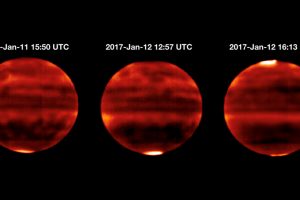ASTRO-Hと呼ばれ、日本、アメリカ、欧州、カナダなどの関係各国のノウハウと技術者と資金を集大成したX線観測衛星が打ち上げられました。
NASAの記事の冒頭と、ASTRO-Hの核心部分の記載をご紹介します。
冒頭(打ち上げ)
New X-ray Space Observatory to Study Black Holes and History of Galaxy Clusters
Editor’s note, Feb. 17, 2016: ASTRO-H launched successfully on Wednesday, Feb. 17, 2016, at 3:45 a.m. EST. The satellite subsequently deployed its solar arrays and is currently functioning normally. ASTRO-H will provide astronomers with a new view of the high-energy universe and has been renamed Hitomi, which translates to “pupil of the eye.”
Editor’s note, Feb. 16, 2016: The launch date for ASTRO-H has been updated to Feb. 17, 2016, at 5:45 p.m. JST (3:45 a.m. EST). The launch window is 5:45 p.m. to 6:30 p.m. JST (3:45 a.m. – 4:30 a.m. EST). The countdown may be watched live on YouTube.
Original story, Feb. 10, 2016:Black hole enthusiasts, galaxy cluster aficionados, and X-ray astronomers have much to be excited about. On Friday, Feb. 12, the Japan Aerospace Exploration Agency (JAXA) will be launching their sixth satellite dedicated to X-ray astronomy, ASTRO-H, from the Tanegashima Space Center in Kagoshima, Japan. The observatory carries a state-of-the-art instrument and two telescope mirrors built at NASA’s Goddard Space Flight Center in Greenbelt, Maryland. The launch is scheduled at 3:45 a.m. EST.
ASTRO-Hは2016年2月17日午前3時45分(東部時間)に鹿児島県種子島宇宙センターから打ち上げられました。無事軌道に乗り「ひとみ」と名付けられました。
ASTRO-Hは、JAXAにとって6番目のX線衛星ですが、最先端の機器を宇宙に運ぶ構造や2つの望遠鏡のミラーはリーランド州にあるNASAのゴダード宇宙飛行センター製です。

X線観測はアメリカをはじめ1980年代から盛んに研究され、多くの知見を得てきましたし、実績も上げてきました。ASTRO-Hにもそのノウハウが提供されており新たな観測成果への期待が高まります。

ASTRO-Hの核心部
One Soft X-ray Telescope focuses light onto an advanced wide-field camera provided by Japan, while the other directs it into the Soft X-ray Spectrometer (SXS), an instrument developed and built by the Goddard team working closely with colleagues from several institutions in Japan. Astronomers typically learn about the composition, temperature and motions of cosmic sources by spreading out the wavelengths of light into a rainbow-like spectrum. But astrophysicists have devised an alternative approach for measuring X-ray “colors,” called microcalorimetry, that produces unprecedented spectral resolution without diluting their intensity as happens in previously employed approaches.

NASAの高度技術が実装されたX線の目と、日本のカメラに関する技術とのコラボでデータ化するそうです。











